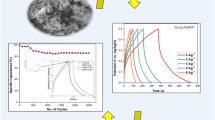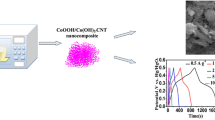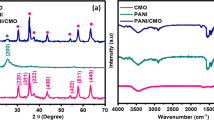Abstract
The excellent cyclic efficiency, superior reversible charge/discharge rate, and high specific power density have made supercapacitors an important class of energy storage systems in recent time. In this study, two nano-ceria-based composites were developed to use as electrode materials in supercapacitor applications. The composites were synthesized by combining ceria with conductive polyaniline (PANI) and doped with HCl and p-toluene sulfonic acid (PTSA). The materials were characterized by FTIR spectroscopy, SEM, XRD, and XPS techniques. Electrochemical studies were performed by cyclic voltammetry, galvanometric charge-discharge, and AC impedance spectroscopy. The CeO2-PANI doped with HCl and PTSA composites displayed ideal supercapacitor behavior showing higher capacitances up to 504 F g−1 and 454 F g−1, respectively, at current density of 1 A g−1 in comparison with pristine ceria (109 F g−1). Both the composites exhibited excellent specific energy (up to 100.8 W h kg−1) as well as outstanding specific power (up to 830 W kg−1). These findings support the possibility of these composites for practical applicability as electrode materials in energy storage devices.






Similar content being viewed by others
References
Poonam, Sharma K, Arora A, Tripathi SK (2019) Review of supercapacitors: materials and devices. J Energy Storage 21:801–825
Zhang LL, Zhao XS (2009) Carbon-based materials as supercapacitor electrodes. Chem Soc Rev 38:2520–2531
Down MP, Rowley-Neale SJ, Smith GC, Banks CE (2018) Fabrication of graphene oxide supercapacitor devices. ACS Appl Energy Mater 1:707–714
Chen S, Ma L, Zhang K, Kamruzzaman M, Zhi C, Zapien JA (2019) A flexible solid-state zinc ion hybrid supercapacitors based on copolymer derived hollow carbon spheres. J Mater Chem A 7:7784–7790
Vangari M, Pryor T, Jiang L (2013) Supercapacitors: review of materials and fabrication methods. J Energy Eng 139:72–79
Kotz R, Carlen M (2000) Principles and applications of electrochemical capacitors. Electrochim Acta 45:2483–2498
Vanitha M, Cao KP, Balasubramanian N (2015) Ag nanocrystals anchored CeO2/graphene nanocomposite for enhanced supercapacitor applications. J Alloys Compd 644:534–544
Wang L, Meng F (2013) Oxygen vacancy and Ce3+ ion dependent magnetism of monocrystal CeO2 nanopoles synthesized by a facile hydrothermal method. Mater Res Bull 48:3492–3498
Fan Z, Meng F, Gong J, Li H, Hu Y, Liu D (2016) Enhanced photocatalytic activity of hierarchical flower-like CeO2/TiO2 heterostructures. Mater Lett 175:36–39
Bibi N, Xia Y, Ahmed S, Zhu Y, Zhang S, Iqbal A (2018) Highly stable mesoporous CeO2/CeS2 nanocomposite as electrode material with improved supercapacitor electrochemical performance. Ceram Int 44:22262–22270
Gong J, Meng F, Fan Z, Li H, Du Z (2017) Template-free controlled hydrothermal synthesis for monodisperse flowerlike porous CeO2 microspheres and their superior catalytic reduction of NO with NH3. J Alloys Compd 690:677–687
Meng F, Gong J, Fan Z, Li H, Yuan J (2016) Hydrothermal synthesis and mechanism of triangular prism-like monocrystalline CeO2 nanotubes via a facile template-free hydrothermal route. Ceram Int 42:4700–4708
Meng F, Zhang C, Fan Z, Gong J, Li A, Ding Z, Tang H, Zhang M, Wu G (2015) Hydrothermal synthesis of hexagonal CeO2 nanosheets and their room temperature ferromagnetism. J Alloys Compd 647:1013–1021
Miah AT, Malakar B, Saikia P (2016) Gold over ceria–Titania mixed oxides: solar light induced catalytic activity for Nitrophenol reduction. Catal Lett 146:291–303
Farahmandjou M, Zarinkamar M, Firoozabad TP (2016) Synthesis of cerium oxide (CeO2) nanoparticles using simple CO-precipitation method. Rev Mex Fis 2:496–499
Andersson DA, Simak SI, Skorodumova NV, Abrikosov IA, Johansson B (2006) Optimization of ionic conductivity in doped ceria. Proc Natl Acad Sci 103:3518–3521
Song E, Choi JW (2013) Conducting polyaniline nanowire and its applications in chemiresistive sensing. Nanomaterials 3:498–523
Wang H, Lin J, Shen ZX (2016) Polyaniline (PANI) based electrode materials for energy storage and conversion. JSAMD 1:225–255
Zhang X, Ji L, Zhang S, Yang W (2007) Synthesis of a novel polyaniline-intercalated layered manganese oxide nanocomposite as electrode material for electrochemical capacitor. J Power Sources 173:1017–1023
Yan Y, Cheng Q, Wang G, Li C (2011) Growth of polyaniline nanowhiskers on mesoporous carbon for supercapacitor application. J Power Sources 196:7835–7840
Deng D, Chen N, Xiao X, Du S, Wang Y (2017) Electrochemical performance of CeO2 nanoparticle decorated graphene oxide as an electrode material for supercapacitor. Ionics 23:121–129
Maheswari N, Muralidharan G (2018) Fabrication of CeO2/PANI composites for high energy density supercapacitors. Mater Res Bull 106:357–364
Gomes EC, Oliveira MAS (2012) Chemical polymerization of aniline in hydrochloric acid (HCl) and formic acid (HCOOH) media. Differences between the two synthesized polyanilines. Am J Polym Sci 2:5–13
Kulkarni MV, Viswanath AK, Aiyer RC, Khanna PK (2005) Synthesis, characterization, and morphology of p-toluene sulfonic acid-doped polyaniline: a material for humidity sensing application. J Polym Sci 43:2161–2169
Ryu KS, Kim KM, Park N-G, Park YJ, Chang SH (2002) Symmetric redox capacitor with conducting polyaniline electrodes. J Power Sources 103:305–309
Parvatikar N, Jain S, Bhoraskar SV, Ambika Prasad MVN (2006) Spectroscopic and electrical properties of polyaniline/ CeO2 composites and their application as humidity sensor. J Appl Polym Sci 102:5533–5537
Lee JSM, Briggs ME, Hu CC, Cooper AI (2018) Controlling electric double-layer capacitance and pseudocapacitance in heteroatom-doped carbons derived from hypercrosslinked microporous polymers. Nano Energy 46:277–289
Iqbal MF, Hassan M, Ashiq MN, Iqbal S, Bibi N, Parveen B (2017) High specific capacitance and energy density of synthesized graphene oxide based hierarchical Al2S3 nanorambutan for supercapacitor applications. Electrochim Acta 246:1097–1103
Binet C, Daturi M, Lavalley J-C (1999) IR study of polycrystalline ceria properties in oxidised and reduced states. Catal Today 50:207–225
Xia H, Wang Q (2003) Preparation of conductive polyaniline/nanosilica particle composites through ultrasonic irradiation. J Appl Polym Sci 87:1811–1817
Razak SIA, Ahmad AL, Zein SHS (2009) Polymerisation of protonic polyaniline/multi-walled carbon nanotubes-manganese dioxide nanocomposites. J Phys Sci 20:27–34
John A, Mahadeva SK, Kim J (2010) The preparation, characterization and actuation behavior of polyaniline and cellulose blended electro-active paper. Smart Mater Struct 19:045011–045016
Reddy BM, Saikia P, Bharali P, Yamada Y, Kobayashi T, Muhler M, Grunert W (2008) Structural characterization and catalytic activity of nanosized CexM1-xO2 (M=Zr and Hf) mixed oxides. J Phys Chem C 112:11729–11737
Chaudhari HK, Kelkar DS (1997) Investigation of structure and electrical conductivity in doped polyaniline. Polym Int 42:380–384
Guo N, Liang Y, Lan S, Liu L, Zhang J, Ji G, Gan S (2014) Microscale hierarchical three-dimensional flowerlike TiO2/PANI composite: synthesis, characterization, and its remarkable photocatalytic activity on organic dyes under UV-light and sunlight irradiation. J Phys Chem C 118:18343–18355
Yan J, Wei T, Shao B, Fan Z, Qian W, Zhang M, Wei F (2010) Preparation of a graphene nanosheet /polyaniline composite with high specific capacitance. CARBON 48:487–493
Chelliah M, Rayappan JBB, Krishnan UM (2012) Synthesis and characterization of cerium oxide nanoparticles by hydroxide mediated approach. J Appl Sci 12:1734–1737
Padmanathan N, Selladurai S (2014) Shape controlled synthesis of CeO2 nanostructures for high performance supercapacitor electrodes. RSC Adv 4:6527–6534
Wang L, Meng F, Li K, Lu F (2013) Characterization and optical properties of pole-like nano-CeO2 synthesized by a facile hydrothermal method. Appl Surf Sci 286:269–272
Li H, Meng F, Gong J, Fan Z, Qin F (2017) Structural, morphological and optical properties of shuttle-like CeO2 synthesized by a facile hydrothermal method. J Alloys Compd 722:489–498
Gong J, Meng F, Yang X, Fan Z, Li H (2016) Controlled hydrothermal synthesis of triangular CeO2 nanosheets and their formation mechanism and optical properties. J Alloys Compd 689:606–616
Meng F, Fan Z, Zhang C, Hu Y, Guan T, Li A (2017) Morphology-controlled synthesis of CeO2 microstructures and their room temperature ferromagnetism. J Mater Sci Technol 33:444–451
Meng F, Wang L, Cui J (2013) Controllable synthesis and optical properties of nano-CeO2 via a facile hydrothermal route. J Alloys Compd 556:102–108
Kuntaiah K, Sudarsanam P, Reddy BM, Vinu A (2013) Nanocrystalline Ce1-xSmxO2-δ (x = 0.4) solid solutions: structural characterization versus CO oxidation. RSC Adv 3:7953–7962
Jaffari GH, Imrana A, Bahc M, Ali A, Bhattib AS, Qurashia US, Shah SI (2017) Identification and quantification of oxygen vacancies in CeO2 nanocrystals and their role in formation of F-centres. Appl Surf Sci 396:547–553
Sarpoushi MR, Nasibi M, Golozar MA, Shishesaz MR, Borhani MR, Noroozi S (2014) Electrochemical investigation of graphene/cerium oxide nanoparticles as an electrode material for supercapacitors. Mater Sci Semicond Process 26:374–378
Prasai D, Tuberquia JC, Harl RR, Jennings GK, Bolotin KI (2012) Graphene: corrosion-inhibiting coating. ACS Nano 6:1102–1108
Yang S, Song H, Chen X (2006) Electrochemical performance of expanded mesocarbon microbeads as anode material for lithium-ion batteries. Electrochem Commun 8:137–142
Yan X, Tai Z, Chen J, Xue Q (2011) Fabrication of carbon nanofiber-polyaniline composite flexible paper for supercapacitor. Nanoscale 3:212–216
Wang Y, Guo CX, Liu J, Chen T, Yang H, Li CM CeO2 nanoparticles/graphene nanocomposite-based high-performance supercapacitor. Dalton Trans 40:6388–6391
Guo S, Wang W, Ozkan CS, Ozkan M (2013) Assembled graphene oxide and single-walled carbon nanotube ink for stable supercapacitors. J Mater Res 28:918–926
Lianbo M, Xiaoping S, Zhenyuan J, Guoxing Z, Hu Z (2014) Ag nanoparticles decorated MnO2/reduced graphene oxide as advanced electrode materials for supercapacitors. Chem Eng J 252:95–103
Acknowledgments
RB is thankful to MHRD, India, for providing fellowship under TEQIP-III scheme. Authors are also grateful to CSIR-NEIST, Jorhat, and Gauhati University for the sophisticated analytical facilities.
Author information
Authors and Affiliations
Corresponding author
Ethics declarations
Competing interests
The authors declare that they have no competing interests.
Additional information
Publisher’s note
Springer Nature remains neutral with regard to jurisdictional claims in published maps and institutional affiliations.
Rights and permissions
About this article
Cite this article
Bortamuly, R., Konwar, G., Boruah, P.K. et al. CeO2-PANI-HCl and CeO2-PANI-PTSA composites: synthesis, characterization, and utilization as supercapacitor electrode materials. Ionics 26, 5747–5756 (2020). https://doi.org/10.1007/s11581-020-03690-7
Received:
Revised:
Accepted:
Published:
Issue Date:
DOI: https://doi.org/10.1007/s11581-020-03690-7




